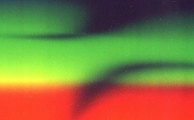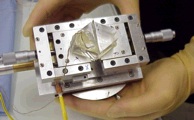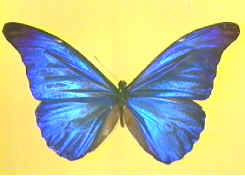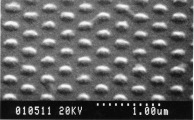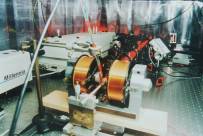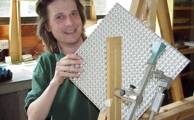
| Physics and Astronomy |
|
| Physics Home | Study here | Our Teaching | Our Research | Our Centres | News | Work here | EMPS |
|
Physics Research
Research groups
See Also
|
||||
Back to top
Electromagnetic Materials ResearchDiffractive OpticsOur research into diffractive optics covers several exciting areas. Experiments to explore surface plasmons on textured surfaces are undertaken, for example to study the total absorption of radiation by metal surfaces. This research is extended in our investigations of photonic surfaces, where we apply photonic band gap concepts to surface modes. We are particularly interested in highly blazed (overhanging) metal gratings and the study of the coupled surface plasmon resonances they support. These structures open up potential for strongly enhanced optical fields, useful for surface enhanced Raman scattering and for the construction of colour selective surfaces. From lessons learnt at visible wavelengths with the excitation of surface plasmons and also through knowledge gained from work on the photonic structures of butterfly wings we are also developing a novel area of research in which we are exploring the microwave response of a wide range of structured surfaces. Our experimental work is complemented by theoretical modeling to allow a fuller understanding to be obtained and potentially interesting structures assessed. More about:
Surface plasmons on textured surfaces, Liquid CrystalsThere are few modern electronic components that do not have a liquid crystal display as one of their primary interfaces of information to the human operator. The science that underpins the functioning of such displays and more particularly that of the next generation forms a major research area. A set of optical waveguiding techniques have been developed at Exeter to allow the detailed exploration of the director profile in a wide range of liquid crystal cell structures. These are being used to explore complex structures in ferroelectric liquid crystal devices; the physics of surface anchoring and hybrid- aligned cells. We are also involved with an exciting new area, that of grating alignment of liquid crystals, something that offers potential for true bistability with nematic structures. Very recently a new developments has evolved. We are pioneering dynamic studies using convergent beam techniques. These allow the determination of director profiles during switching, thereby yielding entirely new information on the switching process and establishing the validity of dynamic theory incorporating the several viscosity coefficients of these anisotropic fluids. More about:
Underpinning physics, Photonics in BiologyThe iridescence seen on the wings of certain species of butterflies and moths has been found to be entirely structural in origin. The structure is that of a series of thin-film multilayers. Several species of Morpho butterflies have been examined in detail. The surface of the iridescent colour producing scales consists of series of longitudinal ridges each of which contain a multilayer structure. Transmission electron micrograph images of cross-sections of the scales reveal that the multilayers form Christmas tree-like structures when viewed end-on. The deep blue iridescent colour of the Morpho wing is caused by selective interference within the scale multilayer structure. Strong non-specular reflection has been discovered that results both from the side-to-side tilting of the multilayer ridges and from diffraction association with the ridge periodicity. More about: Iridescence in Butterflies and Moths. Photonic Control of Light Matter InteractionsMaterials structured on the scale of the wavelength of light are being used to control light matter interactions, for example spontaneous emission may be enhanced or inhibited. is, together with absorption, the commonest interaction between light and matter. We seek to understand the underlying physics of the way such changes arise. Experiments involving molecules placed with nanometre precision near metallic mirrors allow us to explore this fascinating phenomenon and, by combining our results with theory we are able to build our understanding and develop ways to exploit it, for example by improving the efficiency of light emitting devices. In a similar fashion we are exploring how energy transfer between different molecules may similarly be controlled. These fundamental studies form the backbone upon which we are exploring several exciting applications. One of these involves applying photonic concepts to assist the quest for an electrically pumped solid-state organic laser. Thin Film MagneticsThis research has a number of themes. Firstly we use the spin-split bandstructure of ferromagnetic metals to control electronic properties via spin as well as charge, an area known as magneto-electronics. We are currently studying spin-polarized tunnelling in magnetic tunnel junctions that are strong candidates for magnetic sensor and non-volatile Magnetic Random Access Memory applications. Secondly we use a magneto-optical pump-probe technique to investigate the picosecond magnetization dynamics that are fundamental to the operation of microwave frequency devices, and are of increasing importance in the operation of high bit-rate data storage systems. Thirdly we use the same pump-probe technique to study the dynamics of individual spins. We have observed that Nickel thin films may be partially demagnetized on time scales shorter than 300 fs. Although the dynamics of the initial hot electron population are not well understood, the demagnetization may be as short as 10 fs, which raises the prospect of a new ultra-fast magneto-optical data storage technology. More about:
Magnetoelectronics, General InformationPersonnel
Group FacilitiesWe have excellent facilities for sample and device fabrication and characterisation. Sample fabrication takes place in several clean rooms. We make molecularly organized organic structures using the Langmuir-Blodgett technique, magnetic multilayers and tunnel junctions using a UHV magnetron sputtering system and metal/dielectric films using several vacuum evaporators. There is also a designated clean room for liquid crystal cell fabrication. We make many types of novel nano-scale systems with our interfering laser-beam lithography system, and the School's clean room is used for micro-scale patterning of thin films by means of a photo-lithographic lift-off technique. We also have facilities for reactive ion etching and an Atomic Force Microscope. We make CW measurements of reflectance and transmittance, including polarization dependencies and time resolved measurements down to the tens of femto-second regime. There are several CCD based spectrometers and we also employ single photon counting techniques. There are also systems for magnetic and magneto-electronic characterization of thin films, electrical characterization of molecular scale structures and I/V characterisation of liquid crystal cells. See Also |

